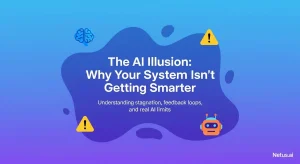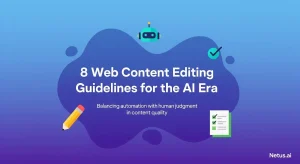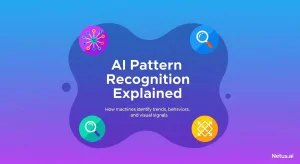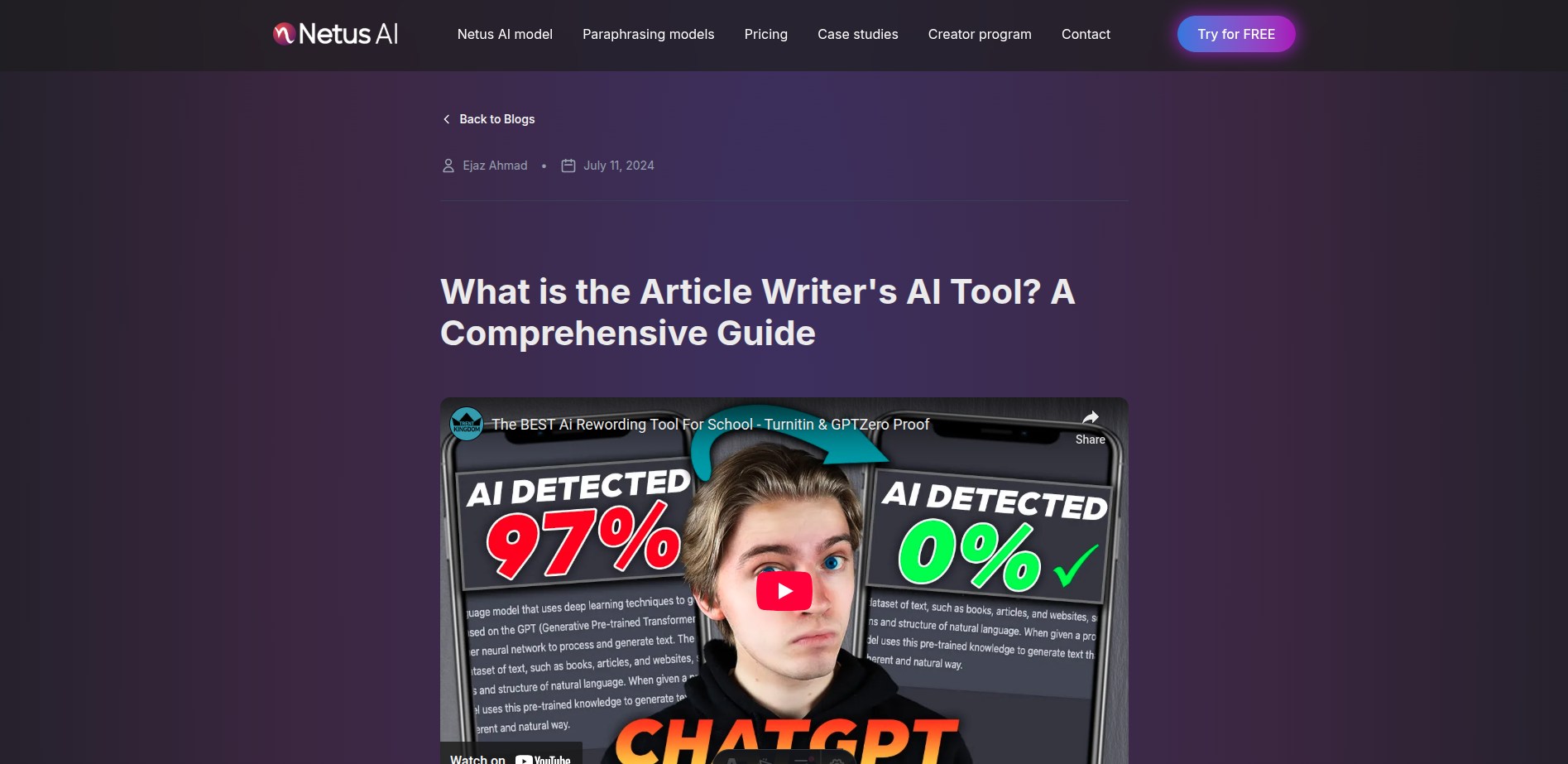What is the Article Writer's AI Tool? A Comprehensive Guide
Ashley Merit
Content writer and editor for Netus.AI
Table of Contents
What is the Article Writer’s AI Tool? An AI tool is a software program that utilizes artificial intelligence to perform certain tasks. AI tools have become increasingly popular in recent years due to their ability to automate tasks, increase efficiency, and reduce errors. One such AI tool is the AI writer, which is designed to generate written content automatically.
AI writers use natural language processing (NLP) algorithms to analyze large datasets and generate written content based on that analysis. This can include anything from blog posts and articles to product descriptions and social media posts. AI writers are designed to mimic the writing style and tone of a human writer, making it difficult to distinguish between the two.
AI writing tools have many benefits, including the ability to save time and increase productivity. They can also help businesses and individuals create high-quality content quickly and easily. However, there are also concerns about the impact of AI on the writing industry and the potential for AI-generated content to be used for unethical purposes. Despite these concerns, AI writing tools are likely to become increasingly prevalent in the coming years as technology continues to advance.
Understanding AI Writing Tools
Evolution of AI in Content Creation
The use of AI in content creation has evolved significantly in recent years. AI writing tools, powered by generative AI and natural language processing, have become increasingly sophisticated, allowing them to produce high-quality content that is virtually indistinguishable from human-written content.
Key Features of AI Writers
AI writers have a number of key features that make them stand out from traditional content creation methods. These features include the ability to generate content quickly and at scale, the ability to optimize content for specific keywords and topics, and the ability to produce content in multiple languages. AI writers are also able to learn and adapt over time, meaning that they can produce better and more accurate content as they are used more frequently.
Diverse Applications in Various Industries
AI writing tools have a wide range of applications across various industries. They can be used to generate product descriptions, blog posts, social media content, and even news articles. In the e-commerce industry, AI writers can be used to generate product descriptions that are optimized for search engines and tailored to specific target audiences. In the news industry, AI writers can be used to generate news articles quickly and efficiently, allowing news organizations to stay on top of breaking news stories.
Overall, AI writing tools are a powerful tool for content creators, marketers, and businesses looking to generate high-quality content quickly and at scale. With their ability to learn and adapt over time, AI writers are likely to become an increasingly important part of the content creation landscape in the years to come.
Benefits of Using AI for Writing
Enhancing Productivity and Efficiency
One of the most significant benefits of using AI for writing is the enhanced productivity and efficiency it provides. AI writing tools can help writers to generate high-quality content in a shorter amount of time, allowing them to focus on other important tasks. For businesses and professionals, this means that they can produce more content in less time, which can lead to increased revenue and a competitive advantage.
Improving Writing Quality and Consistency
AI writing tools can also help to improve the quality and consistency of writing. These tools can detect errors in grammar, spelling, and punctuation, ensuring that the final product is error-free. They can also suggest improvements to sentence structure and word choice, making the writing more engaging and compelling. This is particularly important for businesses and professionals who need to produce high-quality articles and reports.
Cost-Effectiveness for Businesses and Individuals
AI writing tools can also be cost-effective for businesses and individuals. By using these tools, businesses can save money on hiring professional writers or editors. Individuals can also save money by using AI writing tools instead of paying for expensive writing courses or hiring a writing coach. Additionally, AI writing tools can help to reduce the time and effort required to produce high-quality content, which can lead to cost savings in the long run.
In summary, AI writing tools offer a range of benefits for businesses, professionals, and students. They can enhance productivity and efficiency, improve writing quality and consistency, and be cost-effective. By using AI writing tools, writers can produce high-quality content in less time, allowing them to focus on other important tasks.
Integrating AI Writers into the Writing Process
Setting Up and Customizing AI Writing Assistants
Integrating an AI writing assistant into the writing process can be a game-changer for many writers. Setting up an AI writing assistant is usually straightforward, and most tools offer customization options to tailor the experience to the writer’s needs.
Users can typically customize the AI writing assistant’s language, tone, and style to match their writing style. Additionally, some AI writing assistants allow users to create a personal dictionary of commonly used words and phrases. This feature can speed up the writing process and ensure consistency throughout the document.
Overcoming Writer’s Block with AI
Writer’s block can be a frustrating and time-consuming experience. AI writing assistants can help writers overcome writer’s block by providing suggestions for sentences, paragraphs, and even entire sections of a document.
AI writing assistants can also provide inspiration by generating ideas and prompts based on the writer’s topic or keywords. This feature can help writers who are struggling to come up with ideas or who need a fresh perspective.
AI Tools for Research and Outlining
Research and outlining are critical components of the writing process. AI writing assistants can help writers with both tasks.
AI tools for research can help writers find relevant sources, summarize information, and even generate citations. This feature can save writers time and ensure that their research is accurate and up-to-date.
AI tools for outlining can help writers organize their thoughts and ideas. Some AI writing assistants offer pre-built templates for various types of documents, such as essays, reports, and presentations. These templates can help writers structure their documents and ensure that they include all the necessary information.
In conclusion, integrating AI writing assistants into the writing process can be a valuable tool for writers. From setting up and customizing the AI writing assistant to overcoming writer’s block and using AI tools for research and outlining, AI writing assistants can improve the writing process and help writers produce high-quality documents.
Addressing the Challenges of AI Writing
As AI writing continues to gain popularity, it is important to address the challenges that come with it. In this section, we will discuss three major challenges that arise when using AI writing tools: maintaining originality and avoiding plagiarism, ensuring content security and privacy, and dealing with potential bias in AI-generated content.
Maintaining Originality and Avoiding Plagiarism
One of the biggest concerns with AI writing is the potential for plagiarism. While AI tools can help writers generate content quickly, they may also inadvertently produce work that is too similar to existing content. To avoid plagiarism, it is important for writers to use plagiarism checkers and to manually review the content generated by AI tools.
Ensuring Content Security and Privacy
Another challenge with AI writing is ensuring the security and privacy of the content being generated. AI tools may store sensitive information, such as login credentials or personal data, which could be vulnerable to cyber attacks. It is important for writers to use reputable AI tools that have strong security measures in place and to take steps to protect their own data.
Dealing with Potential Bias in AI-Generated Content
Finally, it is important to consider the potential for bias in AI-generated content. AI tools are only as unbiased as the data they are trained on, which means that they may perpetuate existing biases or introduce new ones. To address this, writers should be aware of the potential for bias in their AI tools and take steps to mitigate it, such as using diverse data sets and reviewing the content generated by the tool for any potentially biased language.
In conclusion, while AI writing tools can be incredibly useful, it is important to be aware of the challenges that come with them. By taking steps to maintain originality, ensure content security and privacy, and address potential bias, writers can use AI tools effectively and responsibly.
Optimizing Content for SEO and Marketing
Leveraging AI for Keyword Research and SEO
One of the most significant benefits of using an AI-powered writing tool is the ability to optimize content for search engines. AI tools can help writers identify relevant keywords and phrases that can increase the chances of their content appearing at the top of search engine results pages.
AI-powered keyword research tools can analyze search engine data to suggest relevant keywords and phrases that can be incorporated into the content. These tools can also provide insights into the search volume and competition for each keyword, helping writers to choose the most effective ones.
Creating Engaging Marketing Copy with AI Tools
Creating engaging marketing copy is crucial for any business looking to attract and retain customers. AI-powered writing tools can help writers create compelling marketing copy that resonates with their target audience.
AI tools can analyze customer data to identify the language and tone that is most effective for a particular audience. They can also suggest phrases and words that are likely to resonate with the target audience and increase engagement.
Utilizing AI for Social Media and Blog Content
Social media and blog content are essential components of any content marketing strategy. AI-powered writing tools can help writers create social media and blog content that is optimized for search engines and engaging for readers.
AI tools can analyze social media and blog data to suggest topics and headlines that are likely to resonate with the target audience. They can also help writers create content that is optimized for specific social media platforms, such as Twitter or Instagram.
In summary, AI-powered writing tools can be a valuable asset for writers looking to optimize their content for SEO and marketing. By leveraging AI for keyword research, creating engaging marketing copy, and utilizing AI for social media and blog content, writers can increase the effectiveness of their content marketing strategies.

The shortcomings of content generated by AI | NetusAI
Discover why fast, high-volume AI content often fails to deliver real results. Learn about the crucial missing feedback loop and how implementing performance tracking can transform your AI content strategy.

The illusion of AI: Your system's intelligence gap | NetusAI
Stop wasting marketing spend! Most AI tools don’t learn from results, causing content stagnation and low engagement. Discover why your generative AI isn’t getting smarter and what system actually learns and optimizes content.

Plagiarism and copyright infringement | NetusAI
Learn the distinct differences between plagiarism and copyright infringement. Understand the ethical and legal implications and get practical strategies for avoiding both academic and creative work with NetusAI.

Tips and strategies for mobile content marketing | NetusAI
Optimized for mobile-first indexing, learn 5 essential strategies to capture attention, enhance engagement and drive leads and sales with your mobile content marketing.

Web content editing guidelines for the AI era | NetusAI
Review web content editing guidelines for the AI era. Learn how to edit AI-generated content, ensure authenticity and optimize for SEO and readability.

Explaining AI pattern recognition | NetusAI
AI pattern recognition enables machines to identify trends for diverse applications, from detecting plagiarism to fraud. Discover its processes, models and real-world benefits.

